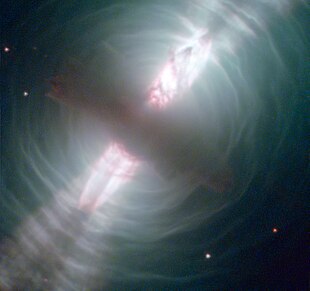CRL 2688
|
Protoplanetary Nebula CRL 2688 / AFGL 2688 |
|
|---|---|

|
|
| Photo of the Hubble Space Telescope with the WFC3 camera | |
| AladinLite | |
| Constellation | swan |
|
Position equinox : J2000.0 |
|
| Right ascension | 21h 02m 18.3s |
| declination | + 36 ° 41 ′ 37 ″ |
| Appearance | |
| Angular expansion | 30 ″ × 15 ″ |
| Central star | |
| Physical data | |
| distance | approx. 3000 ly |
| history | |
| Date of discovery | 1975 |
| Catalog names | |
| PK 080-06 1 • IV Zw 67 | |
CRL 2688 (also AFGL 2688 or RAFGL 2688 or eggs fog , English Egg Nebula ) is a bipolar proto planetary nebula , about 3000 light-years away. The object was discovered in 1975 as part of the Palomar Observatory Sky Survey .
The most noticeable structure of the nebula is a series of bright arcs and circles that surround the central star. This itself is covered by a dense layer of gas and dust, so direct observation of the central star is not possible. However, the light from the central star penetrates the thinner areas and allows the outer gas areas to shine, thus creating the arcs in the appearance.
CRL 2688 is among the closest and best studied bipolar protoplanetary nebulae.
literature
- De Ruyter et al .: Keplerian discs around post-AGB objects: a common phenomenon? In: Astronomy & Astrophysics 448 (2006), pp. 641-653.
- EP Ney et al .: Studies of the infrared source CRL 2688 . In: Astrophysical Journal Vol. 198 (June 15, 1975), pp. L129-L131, L133, L134, doi : 10.1086 / 181829 , bibcode : 1975ApJ ... 198L.129N
- R. Sahai et al .: The structure of the prototype bipolar protoplanetary nebula CRL 2688 (Egg Nebula): broadband, polarimetric and H2 line imaging with NICMOS on the Hubble Space Telescope. In: Astrophysical Journal 492 (1998), L163-L167, PDF; 3.79 MB
Web links
- Easter in the sky: the egg fog
- D. Le Mignant (Keck Observatory): Combined image HST / ACS F808W, Keck LGS AO NIRC2 Kcont and H2
- astronews.com: An aging star in bright colors & picture of the day
Individual evidence
- ↑ SIMBAD Astronomical Database . In: CRL 2688 . Retrieved April 30, 2012.
- ^ Ney et al .: Studies of the infrared source CRL 2688 . In: ApJ 198 (1975)
